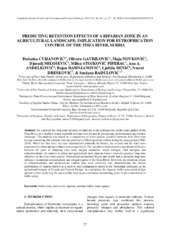Приказ основних података о документу
Predicting Retention Effects of a Riparian Zone in An Agricultural Landscape: Implication for Eutrophication Control of the Tisza River, Serbia
| dc.creator | Cvijanović, Dušanka | |
| dc.creator | Gavrilovic, Olivera | |
| dc.creator | Novković, Maja | |
| dc.creator | Milošević, Đurađ | |
| dc.creator | Stojković Piperac, Milica | |
| dc.creator | Anđelković, Ana | |
| dc.creator | Damnjanović, Bojan | |
| dc.creator | Denić, Ljubiša | |
| dc.creator | Drešković, Nusret | |
| dc.creator | Radulović, Snežana | |
| dc.date.accessioned | 2023-07-12T11:28:06Z | |
| dc.date.available | 2023-07-12T11:28:06Z | |
| dc.date.issued | 2023 | |
| dc.identifier.issn | 1842 - 4090 | |
| dc.identifier.issn | 1844 - 489X | |
| dc.identifier.uri | https://plantarum.izbis.bg.ac.rs/handle/123456789/663 | |
| dc.description.abstract | We explored the long-term influence of land use in the riparian zone on the water quality of the Tisza River, as a model of a non-wadeable lowland river located in a temperate, predominantly agricultural landscape. The analysis was based on a comparison of water quality variables between three river sites having contrasting, but constant land use patterns (in 500 m upstream radius) during the study period (2006-2019). While the first river site was characterized primarily by forests, the second and the third were dominated by urban and agricultural areas respectively. The variables which showed a significant difference between the pairs of sampling sites were oxygen saturation, nitrite nitrogen, total nitrogen, and orthophosphates. In contrast to urban and agricultural land, riparian forests showed a positive long-term influence on the river water quality. Natural and seminatural forests and shrubs had a favorable long-term influence on nutrient concentrations and oxygen regime of the Tisza River. However, the retention effects of orthophosphates and nitrite/nitrate content here were relatively low, demonstrating the limited performance of riparian buffers as a main or only management option in the Pannonian landscape, as the agricultural hotspot of Central and Eastern Europe. In conclusion, the riparian buffer assessment design applied in this study may be successfully used in pre-restoration monitoring, prior to the construction of buffer strips. | sr |
| dc.language.iso | en | sr |
| dc.publisher | Carpathian Association of Environment and Earth Sciences | sr |
| dc.relation | info:eu-repo/grantAgreement/MESTD/inst-2020/200125/RS// | sr |
| dc.relation | info:eu-repo/grantAgreement/MESTD/inst-2020/200124/RS// | sr |
| dc.relation | info:eu-repo/grantAgreement/MESTD/inst-2020/200010/RS// | sr |
| dc.rights | openAccess | sr |
| dc.rights.uri | https://creativecommons.org/licenses/by/4.0/ | |
| dc.source | Carpathian Journal of Earth and Environmental Sciences | sr |
| dc.subject | buffer zone | sr |
| dc.subject | land cover | sr |
| dc.subject | riparian | sr |
| dc.subject | riparian buffer | sr |
| dc.subject | water quality | sr |
| dc.title | Predicting Retention Effects of a Riparian Zone in An Agricultural Landscape: Implication for Eutrophication Control of the Tisza River, Serbia | sr |
| dc.type | article | sr |
| dc.rights.license | BY | sr |
| dc.citation.epage | 36 | |
| dc.citation.issue | 1 | |
| dc.citation.spage | 27 | |
| dc.citation.volume | 18 | |
| dc.type.version | publishedVersion | sr |
| dc.identifier.doi | 0.26471/cjees/2023/018/23 | |
| dc.identifier.fulltext | http://plantarum.izbis.bg.ac.rs/bitstream/id/2804/bitstream_2804.pdf |


